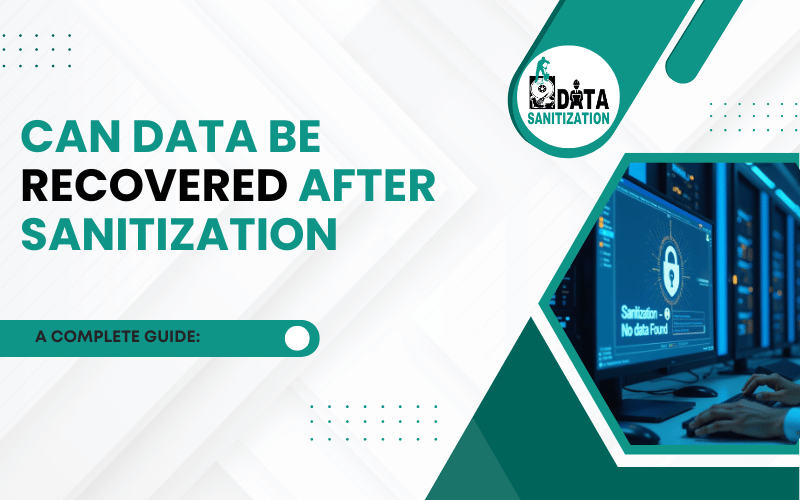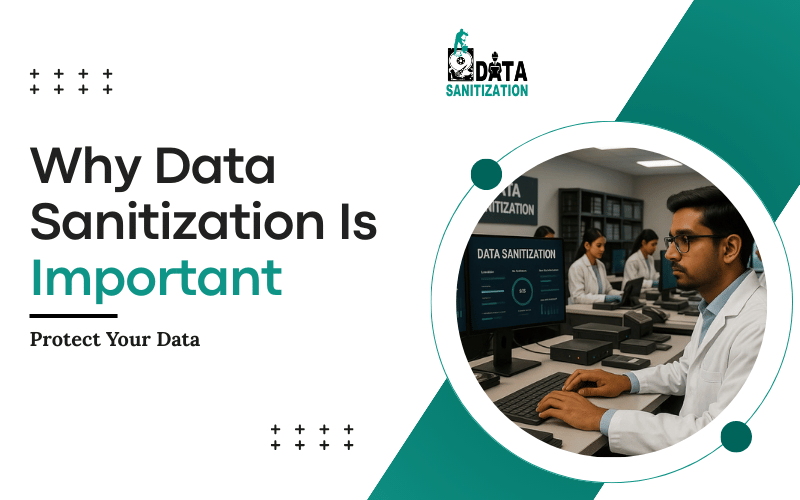In today’s digital age, data security is more important than ever. Whether you’re an individual or a business, securely deleting sensitive data from your storage devices is critical to prevent unauthorized access. This is where data sanitization comes in—a process designed to permanently erase data from storage devices like hard drives (HDDs), solid-state drives (SSDs), flash drives, and other types of disk storage.

But here’s the burning question: Can data be recovered after sanitization? The short answer is—it depends. In this article, we’ll explain what data sanitization really means, why data remanence can make recovery possible, and how forensic experts might still recover wiped data from sanitized storage devices. Plus, we’ll give you practical tips on how to ensure your data stays truly gone.
 What is Data Remanence?
What is Data Remanence?
Data remanence refers to the traces or remnants of data that remain on storage devices even after deletion or sanitization attempts. This is a crucial concept because it’s the reason why data recovery after sanitization is sometimes possible.
Different types of storage devices behave differently:
💽 Traditional hard drives (hdds): store data magnetically, which means overwritten data can sometimes be reconstructed using specialized techniques
💾 Solid-state drives (ssds): use flash memory and complex wear-leveling algorithms. this makes sanitization tricky since data might still reside in hidden or trimmed blocks
🔌 Flash drives and other nand-based devices: also have unique challenges due to the way data is stored and erased
🔍 Can You Recover Data After Sanitization?
Yes, but it depends on the method of sanitization used and the technology of the storage device. Some sanitization methods are more secure than others:
Common Sanitization Methods:
✏️ Overwriting / multi-pass wipe: writing random data multiple times over the original content. effective for hdds but less so for ssds due to wear-leveling
🔐 Cryptographic erase: encrypting data and then deleting the encryption key. this method is strong but can be vulnerable if key management is weak
🧲 Degaussing: applying a strong magnetic field to disrupt data on magnetic storage (only works on hdds)
🧨 Physical destruction: physically shredding or destroying the device to prevent any recovery
🧹 Secure erase and ssd trim: special commands that signal ssds to delete data blocks. however, forensic recovery can sometimes retrieve trimmed data
🕵️♂️ How Forensic Experts Recover Data
Even after sanitization, forensic recovery tools and advanced lab techniques might recover wiped data:

⚡ Analog sanitization recovery: exploiting small voltage differences in nand flash to retrieve data
🔍 Data carving after wiping: searching for leftover file fragments on a drive
🧬 Recovering from trimmed ssds or scrubbed nand: using specialized software to analyze and reconstruct deleted data
⚠️ These methods require expensive equipment and deep technical knowledge, so they are mostly used by law enforcement or professional data recovery services.
✅ How to Ensure Your Data is Truly Gone
If you want to make sure your data cannot be recovered, here are some best practices:

🛡️ Use certified sanitization tools: follow standards like nist 800-88 or dod 5220.22-m for reliable sanitization
🔄 Combine methods: for example, overwrite data first, then perform a cryptographic erase or physical destruction
📋 Validate sanitization: use third-party verification services to confirm your data is irrecoverable
💣 Consider physical destruction: for highly sensitive data, shredding or destroying the physical drive is the safest option
💡 Be aware of storage types: differentiate your method depending on whether it’s an hdd, ssd, or flash drive
🧾 Conclusion
While modern data sanitization methods significantly reduce the risk of data recovery, no method is 100% foolproof without proper implementation and verification. if you’re dealing with sensitive or confidential data, the best approach is to:
🧩 Combine multiple sanitization techniques
🧠 Stay informed about your device’s technology
🤝 Consider professional help for both sanitization and data recovery
By understanding data remanence, the limitations of various sanitization methods, and how forensic recovery works, you can better protect your data and make informed decisions about how to securely erase it.
🛡️ Why Choose Data Sanitization — Your Trusted Data Sanitization Company
When it comes to securely erasing sensitive data, experience and reliability matter. at data sanitization, we specialize in comprehensive data sanitization services designed to meet the highest industry standards, including nist 800-88 and dod 5220.22-m. whether you need secure erasure of hdds, ssds, flash drives, or cloud storage, our expert team uses advanced tools and proven techniques to ensure your data is completely unrecoverable.
We offer:
🏅 Certified and verified data sanitization
🧰 Customized solutions for businesses and individuals
🕵️ Forensic-grade data destruction and validation reports
🌐 Support for complex environments including raid arrays and encrypted drives
🔐 Protect your business, customers, and compliance requirements with data sanitization — the trusted data sanitization company dedicated to your data security and peace of mind.
Need Onsite Data Sanitization Services?
Do you want Data Sanitization Services to be provided at your location? No worries!! We got it covered. Our team members will be appointed to finish the job at your location after you book the appointment with us. Please feel free to contact us.


